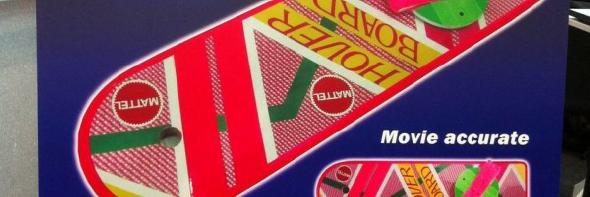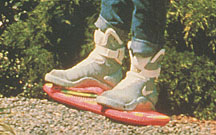
Claim: The hoverboards used in the film Back to the Future
II weren't merely creative special effects; they were real!
 False
False
Example:[Collected on the Internet, 1994]
In the movie Back to the Future II, the hero rides a pink
hoverboard and saves the day, etc. A very prevalent legend that
circulated around the schools when this movie came out was that some
toy company had actually developed a working hoverboard, and were
planning to release it as soon as the movie was out of theaters. The
release of the board not occurring, the rumor was appended to be such
that someone had been killed/severely injured in the playtesting of the
hoverboard, and the resulting suit from the child's parents kept the
hoverboard from being ever put into production.
Origins: One of the more memorable details of Back to the
Future II (1989), the second entry in the Back to the Future
trilogy, were the incredible hoverboards depicted in that film.  In a futuristic tie to
In a futuristic tie to
the original Back to the Future, the sequel (set thirty years in the
future from the original, in the year 2015) featured airborne hoverboards,
a 21st century updating of the skateboard Marty McFly
opportunistically "invented" in 1955 to escape a gang of pursuing bullies.
But unlike the earthbound versions of bobbysoxer times, these Back to
the Future II boards could fly.
Naturally such a sight prompted lust in the hearts of kids and teens who
saw the picture. They envisioned themselves swooping though air on these
gadgets, and the wish for such a product created the belief that
there actually was such a product. Besides, the name "Mattel" was
printed on those things; that must have meant they were real! (Actually,
Back to the Future II was somewhat infamous for the
number and prominence of product placements salted throughout the film. Had
the hoverboard not had a logo on it, that would have been
remarkable.)
In the world of lore, we call this a wish fulfillment legend; in the hearts
of those kids, it was only right that wanting something so much could
transform it into reality.
Young folks came charging out of the theaters with their heads filled with
vivid images of hoverboards and of themselves smugly swooping along on
them, the envy of all theymet. Whispers quickly spread that it wasn't just
special effects up on that screen; those were real flying
hoverboards and, even better, they'd be in the stores soon!
But of course there was nothing to any of it. Hoverboards were naught but
ordinary movie special effects wizardry, created by suspending actors from
a rig on the back of a truck and driving them around Courthouse Square (a
fixed shooting location in Universal's back lot in Hollywood) on
hoverboards that were nailed or glued to their feet to appear as if they
were floating in the middle of nowhere. Scenes where the hoverboards seem
to jump up and snap onto the riders' feet were created with the help of
rare earth magnets secreted in the actors' shoes. Closeups were effected by
posing hoverboard-riding actors in front of a blue screen, then afterwards
melding these shots with footage of the background scene.
Robert Zemeckis, the film's director and special effects genius, became fed
up with people asking him how the hoverboard sequences were done, and,
according to Michael J. Fox, he began answering, "What do you
mean, how did we do it? It's a real hover-board. It flies. Michael
[J. Fox] just practiced a lot." His exasperation-fueled
flippancy only served to heighten the rumor; now even the director was
confirming it!
The hoverboard's failure to appear on toy store shelves was attributed to
pressure brought to bear upon Mattel by parents' groups concerned for the
safety of children, and once again Zemeckis was right there to stir the
pot: "Hoverboards have been around for years, but parents' groups worry
that kids will get hurt, so they've pressured the toy companies not to put
them on the market," he said. "We got our hands on some."
The DVD set of the Back to the Future trilogy has Zemeckis saying
"we got our hands on a couple of these hover boards after toy companies
were banned from producing them" and one of the features includes footage
of stunt men testing the hoverboards in a field. But this is just more of
the leg-pull.
Further non-Zemeckian extensions of the rumor told of a tester who died in
a particularly gruesome accident, his death leading Mattel to rethink the
whole concept.
Mattel was besieged with inquiries about where and when buyers could
purchase hoverboards. "In most cases, we make it clear it was made
specifically for the movie," said Glenn Bozarth of Mattel back in 1989 when
the phones were ringing off the hook. "But if they've got a sense of humor,
we tell them to wait until 2015."
In March 2014, the supposed HUVr
Tech company proclaimed "the hoverboard has arrived" and released a
video (featuring, among other celebrities, actor Christopher Lloyd, who
portrayed Doc Brown in the Back to the Future series) purportedly
showing such devices in action:
This video was created by Will Ferrell's Funny or Die company, the
same outfit responsible for the previous year's fake video featuring
NASCAR's Jeff
Gordon supposedly pranking an unsuspecting car salesman. Of the HUVr
video, TechCrunch wrote:
If you're looking for a well-crafted but ultimately very fake video
about hoverboard technology featuring Moby, Terrell Owens, Tony Hawk
and Dr. Emmett Brown himself, today is your lucky day. The
video above is exactly what I've described, featuring a weird cast of
cameos and what appears to be a fake tech team powering everything,
plus a soundtrack with Chromeo and Best Coast. Also there's a Mark
Cuban endorsement to complete the strange assembly.
The tagline is that the "Future Has Arrived," when in fact it
hasnÂÂÂÂÂ’t. Aside from being a clear (though still technically
impressive) fake, the website for this demo and fake company also shows
a counter with December 2014 as the projected "destination time" for
whatever's going on here. That could just be part of the artificial
HUVr product dressing, but it could also be when whatever's being
promoted here breaks cover.
The International Business Times also noted that:
It seems pretty real until you dive into the legal section of HUVr's
website, which says, "the inclusion of any products or services on this
website at a particular time does not imply or warrant that these
products or services will be available at any time."
There are also clues in the video that it's a hoax. At 2:10, it is
clear that wires attached to a harness are the real cause of Terrelle
Owens lifting into the air.
HUVr's website says that the HUVr Board demonstration is a marketing
scheme to attract investors, saying that the team and investors are
"marketing this exciting consumer product in order to fund ongoing
R&D."
Even though HUVr Boards likely aren't on their way anytime soon, HUVr
could be developing some very exciting technology. This YouTube video
certainly got the Internet talking about them.
Barbara "bleck! to the future" Mikkelson
Last updated: 4 March 2014
|
|
Sour |
